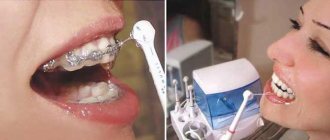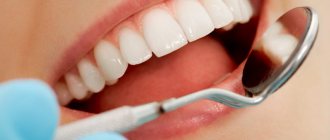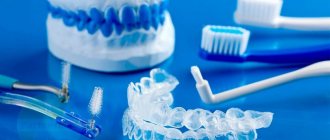The main purpose of tooth enamel is to protect teeth from negative external influences, which often lead to their destruction. Therefore, dentists recommend providing her with gentle care. If this is not done, the protective shell will darken and lose its functions. This can be caused not only by improper dental care and frequent use of low-quality or whitening toothpastes, but also by bad habits, diseases of internal organs, etc.
Today, there are many techniques that help lighten the enamel by several tones. The safest and most effective is restorative teeth whitening, or lamination. Why this particular technique should be preferred if you want to make your smile beautiful, we will find out further.
Restorative teeth whitening
Efficiency
The purpose of restorative teeth whitening is to make the enamel white, protect against negative external influences, including the accumulation of bacteria, reduce sensitivity and eliminate small defects. The essence of this procedure is, as a rule, as follows: thin plates of dense material, which are made in the laboratory, are attached to the front surface of the incisors. They usually follow the shape of dental crowns. Such plates are not inferior in strength to natural enamel and are almost invisible.
The initial state
If the patient wishes, the doctor can always change the plates or return the teeth to their original state. This is very important, since sometimes the shade of the plate chosen by the patient turns out to be too white in practice and can burden the owner of this smile. In the case of ceramic veneers, fixing this will be quite expensive and difficult, but the plates can be easily adjusted by simply choosing a new color. And if a person is completely satisfied with the results of restorative bleaching, then in the future one can use porcelain or zirconium dioxide, which are the most durable materials.
Indications for use
It is advisable to perform restorative teeth whitening if the following defects are observed:
- The presence of dark spots that appear on the enamel along with traces of silver fillings.
- The presence of fluorosis and “tetracycline teeth”.
- Development of increased sensitivity of the incisors.
- The appearance of minor damage in the coronal area of the tooth.
- Presence of small cracks.
It is worth paying attention to the fact that restorative bleaching is a cosmetic procedure and is aimed primarily at eliminating an aesthetic defect. If the condition is more serious or the deficiency is more significant, you should consider other restorative techniques, discussing any possible options with your doctor.
Indications and contraindications
- {amp}gt;Development of fluorosis (appearance of white spots on the surface).
- Minor damage to the enamel.
- Presence of small cracks.
- Increased sensitivity of teeth.
If the damage to the enamel is significant or there are any diseases of the oral cavity, the procedure is not performed. Also, restoration is contraindicated during pregnancy and lactation, in case of infectious diseases and oncology.
How is it done?
First, the teeth are thoroughly cleaned using a special paste. After this, a composition is applied to them that prevents the appearance of bacteria and reduces the sensitivity of the enamel. An overlay is fixed on top, which is subsequently polished. Before the procedure, professional cleaning may be performed to remove plaque and tartar.
Special plates are usually made of composite materials, making the method affordable for different categories of patients.
By contacting the Danaya clinic in St. Petersburg, you can count on the following:
- Excellent cosmetic result.
- Favorable prices and various discounts.
- Highly qualified specialists.
- Fast execution due to the use of high-quality equipment.
You can make an appointment using a special form on the website or by phone. We will be waiting for you at our medical center!
Ask your question
There are many reasons why patients resort to this technology. The list of the most common ones, for example, includes:
- thinning of the enamel due to previous procedures;
- high sensitivity, which does not allow resorting to conventional lightening methods;
- tetracycline tooth syndrome;
- weak effect obtained after photobleaching;
- a significant change in shade due to many years of use of cigarettes or products containing dark pigments;
- fluorosis
However, most likely, this method of restoring whiteness will have to be abandoned by those who are diagnosed with:
- microcracks in enamel;
- serious chips;
- caries at any stage;
- periodontal disease and other diseases.
However, there is a big but - it is enough to cure your teeth first, and no problems will arise in the future.
Most often, restorative teeth whitening is resorted to in the following cases: • thinned enamel with increased sensitivity, which does not allow resorting to classical whitening methods; • the presence of tetracycline teeth; • insufficient effect after photobleaching; • fluorosis; • yellowing of tooth enamel as a result of prolonged smoking or under the influence of consuming large amounts of dyes.
This technique is famous for its good tolerability and almost complete absence of contraindications. So, it is allowed even for pregnant women and breastfeeding women. Relative contraindications include severe cracks or chips in the teeth, as well as the presence of periodontal disease and caries. In these cases, it is necessary to first treat the underlying disease, and then directly perform restorative teeth whitening.
DETAILS: Chicory after teeth whitening
pros
The procedure associated with restorative teeth whitening has a number of serious advantages that distinguish it from other methods, but there are also disadvantages. Let's start with the pros:
- The ability to accurately determine the final shade and level of enamel whiteness, in contrast to traditional bleaching variations.
- No mechanical or chemical effects on natural enamel.
- The ability to easily adjust the color of the incisors at any stage of the cosmetic procedure.
- There is complete absence of damage to the enamel in cases where the patient wishes to return the teeth to their immediate original state.
- Absolutely painless procedure and quick results.
- The cost of restorative bleaching is significantly lower compared to alternative options.
Minuses
Now we list the disadvantages of modern teeth whitening methods:
It is important to note that restorative teeth whitening eliminates mechanical impact on the enamel, which distinguishes it from procedures using veneers and crowns.
Caring for your teeth after the whitening procedure
To keep your teeth white for as long as possible, you should follow several useful recommendations. Here are the most basic and useful of them:
- Avoid eating foods that can stain your teeth.
- It is not recommended to eat hard and sticky foods.
- It is necessary to maintain oral hygiene. You need to brush your teeth 2 times a day - in the morning and before bed.
- Once every six months you need to visit the dentist for restoration.
Only by following these rules can you achieve lasting results.
Let your smile shine!
Description of the procedure
We’ll look at prices for teeth whitening in dentistry below, and now let’s look at the procedure. It has five stages:
- Surfaces are cleaned of plaque and tartar, caries is treated, and, if necessary, old fillings are replaced.
- The surface of the incisors is thoroughly polished and coated with an antibacterial compound.
- The patient selects the color of the overlays using a special shade scale.
- The plates are fixed to the front tooth surface with an adhesive containing a therapeutic component that reduces sensitivity and helps prevent the accumulation of various bacteria.
- The overlays are polished, a micro-relief is created in order to give them an absolute resemblance to enamel.
How is the procedure carried out?
The process is quite simple and is carried out in just a few steps. Each of them is described in the table.
| Stages of the procedure | What is |
| Professional cleaning | First, the doctor carries out professional teeth cleaning, freeing them from stone and plaque. If other diseases are present, they must be cured |
| Polishing | For better attachment and easy application, the doctor will carefully polish the enamel and apply an antiseptic composition. |
| Selecting a shade | Dentist offers patient options for enamel shade |
| Attaching plates or applying filling material | Depending on the chosen method of restorative whitening, the doctor will either attach the plates with glue or apply a special coating to the surface of the teeth. |
| Final polishing | The teeth are polished again for an aesthetically pleasing appearance. |
After this, the dentist will tell the patient about the rules regarding dental care after lamination.
Video - Installation of lumineers
Video - Lumineers installation procedure
How much does this whitening cost?
This service is provided by many clinics in the country, and the price of teeth whitening in dentistry can vary from two and a half to twelve thousand rubles per unit.
This largely depends on the type of installation (it can be direct or indirect), the material used, the choice of microprostheses (whether it is a template blank or a lumineer made from individual impressions) and the level of the clinic itself. The attending physician will help determine the exact price for the client. On average, this procedure can cost three times less than installing veneers.
Composite teeth whitening
The technique involves the use of a layer of composite material with a light shade, which is applied to the outer surface. During this whitening, boron treatment is not used; the enamel is treated only with a weak acid solution for one minute. At the same time, it is not destroyed in any way, since the processing depth is less than a thousandth of a millimeter.
After this, a special glue is applied to the surface of the incisors, then a composite of the required shade is fixed on top. This stage is considered very important, and much depends on the experience of the dentist. Each layer of composite material must have a uniform shade, as well as the desired thickness, otherwise the teeth will look too prominent or the darker natural enamel will show through.
If all conditions have been taken into account and the work is done efficiently, the service life of the bleaching can be five years. After this, the composite layer should be renewed or removed without any harm to the enamel.
The main advantages of restorative teeth whitening over competitors
Among the various methods of lightening enamel, almost all involve some kind of impact on it, which can result in harm. Restorative teeth whitening takes a completely different approach. We will describe the essence of the method, prices and reviews from satisfied customers.
Having understood what such a service for restoring the beauty of a smile is, you can safely try it in practice. Moreover, the advantages and positive effects in this case will be much greater than with any other popular option.
Features of the technique
What is restorative teeth whitening? This is a modern way to add beauty to your smile without mechanical or chemical effects on the enamel structure. The main features of the procedure are:
- By applying a thin layer of material to the front surface of the teeth, any desired shade can be easily applied to the row.
- Due to this, the enamel structure is reliably protected from the aggressive effects of bacteria, which has a beneficial effect on dental health.
- In one visit to the dentist, you can completely solve the problem of the appearance of your smile with minor defects.
- To constantly maintain the result, it is enough to periodically, once every six months, visit the dentist’s office for polishing and light correction.
And if with any other methods of whitening, especially oxygen and chemical ones, the enamel can become thinner, and a person begins to suffer from sharp reactions to cold and hot, then whitening teeth using restoration methods is much more useful. After all, the fabric will not only become lighter, but healthier and stronger.
Indications and contraindications
Any dental patient may wish to lighten their teeth using this method. At the same time, special indications for the procedure will be those cases when it is almost impossible to change the shade of the enamel with other whitening systems:
- presence of stains from silver filling material;
- fluorosis;
- darkening of teeth from taking tetracycline drugs;
- thinned enamel and increased sensitivity;
- minor defects in the dentition, surface damage;
- the presence of small cracks that you also want to hide.
Only if the violations are too large, then it will be necessary to choose another restoration method. Due to the safety of lamination (as this whitening system is otherwise called), we can guarantee the absence of any contraindications to its implementation. But it is still worth discussing with your doctor the adequacy of this choice.
Advantages and disadvantages
A number of advantages and disadvantages separate this whitening method from other popular systems:
- There are no painful sensations observed during the process.
- The patient can independently choose the desired shade of the dentition that he wants to achieve.
- The entire procedure does not last long and is carried out in one go.
- Possibility to adjust the enamel color at any stage.
- If you are not satisfied with the result, then it is always possible to completely remove the plates and return to the previous state without any unpleasant consequences.
- There is no chemical or mechanical effect on the surface, which keeps the enamel intact and healthy.
- The plates themselves help protect the dentition from bacteria and even reduce natural sensitivity.
- This procedure is considered more affordable, since its cost is lower than many whitening and restoration systems in dentistry.
But there are also a number of disadvantages:
- It will not be possible to carry out such a procedure at home. And every six months you should visit the dentist for correction and polishing.
- If there are significant defects in the dentition, then such whitening will be impossible.
- The method is used only on the anterior units that are included in the smile zone. With increased load on the chewing side, the plates will immediately peel off.
Methods of restorative teeth whitening
This type of restoration can occur in two ways:
- Direct – when a thin layer of composite material is applied to the enamel surface and the shade is selected during the bleaching process.
- Indirect - initially suitable plates are selected, and in some cases they are made to suit individual characteristics. And only after that they are glued to the surface of the teeth.
Each of the options is considered safe for the enamel structure and brings the desired result. But if the plates are made exactly to the shape of the patient’s teeth, the price can rise significantly.
How is the procedure carried out?
The whole process is quite simple and painless; it takes place in five stages:
- As before any other type of service in aesthetic dentistry, you should initially clean the oral cavity and surface of the teeth from plaque, stone, treat caries and eliminate other diseases.
- For better application and attachment of the material, the doctor will carefully polish the enamel and cover it with an additional antibacterial compound.
- Next, the patient, together with the dentist, will select the desired and most suitable shade of the plates.
- The specialist will use glue to attach the selected material to the surface of the teeth or apply a special coating, depending on the specific method of restorative whitening.
- This material will be additionally polished and made into a natural shape, giving the smile a beautiful appearance.
Post-procedure care
In order for the result to please you for a long time, you need to follow the basic rules that the dentist will tell you about upon completion of the restoration:
- Regular oral hygiene remains unchanged.
- For a longer-lasting whitening effect, it is recommended to give up coloring foods and drinks (white diet), and also quit smoking.
- You should not perform unnecessary manipulations with your restored front teeth - biting off threads, gnawing hard objects, pencils, etc.
- Visit your dentist every six months for polishing and adjustments.
Only in this case can you guarantee a permanent whitening effect and enjoy an ideal whiteness and integrity of your smile.
: restorative teeth whitening.
Price
If you are concerned about how much such an effective and safe whitening procedure costs, then you need to find out specific prices directly from the clinic where you are going to have it performed.
After all, the cost may vary significantly depending on the number of units processed, the pricing policy of private dentistry and the chosen correction method. On average in Moscow, restorative whitening costs 2500-3000 rubles per tooth.
Reviews
Nikolay:
I wanted to whiten my teeth with a laser. But the doctor said that my enamel is too thin and this method is not suitable, like many others. But he suggested restorative bleaching. I am very grateful to him for this, as I got a brilliant smile while maintaining healthy teeth.
Benjamin:
Due to the large number of fillings in the mouth, the appearance of a whole series is rather unaesthetic. There was no way to bleach them, since chemical compounds have no effect on such material. Using the restoration, I at least restored the smile zone and now I am not ashamed to laugh and communicate with people.
Diana:
I have dreamed of snow-white teeth for a long time. But I didn’t want to spoil the enamel with any chemicals. Ultrasound gave a weak lightening effect. Having tried restorative bleaching, I was very pleased. Now you just need to get rid of bad habits so as not to spoil the result.
Loading …
Dental reference book
Tooth structure
Source: https://infozuby.ru/restavracionnoe-otbelivanie-zubov.html
Advantages
The following advantages of this technology are highlighted:
- Availability of a wide palette of shades (you can choose from twenty tones of white).
- The teeth do not require grinding.
- It only takes three hours for a person to become the owner of a snow-white smile.
- There are no changes in color over time.
- Availability of an affordable price and no negative effect on enamel.
Composite whitening is an excellent choice when clients do not have enough time or money for a full restoration, but at the same time the person really wants to be the owner of the so-called Hollywood smile. Considering that composite whitening is carried out in just a few hours, it can be easily performed before important or festive events in life.
Cosmetic whitening at the dentist
Whitening methods that are used today in aesthetic dentistry are divided into two types:
Mechanical teeth whitening at the dentist includes professional cleaning techniques. In this case, modern equipment is used, which allows you to remove any mineral deposits from the enamel. The effectiveness of cosmetic lightening is manifested as a result of plaque removal. Its accumulation on teeth is especially dangerous in the area of contact between enamel and gums, and it is not possible to remove this unpleasant factor with a hygienic brush. Therefore, mechanical technology, in addition to whitening cosmetic functions, is one of the key procedures that allows one to cope with diseases such as periodontal disease and gingivitis.
The second type of teeth whitening at the dentist (enamel lightening) is chemical and is based on the use of bleaching substances that penetrate the enamel tissue. For this, hydrogen or carbamide peroxide is used. An oxygen gel that contains these substances is applied to the frontal area of the row. The Hollywood smile area includes ten teeth in the upper jaw and exactly the same number of teeth in the lower jaw; therefore, during the procedure, the gel is applied to this area.
Depending on the degree of hydrogen concentration, cosmetic teeth whitening takes from three to fifteen minutes. As part of conventional chemical lightening of enamel, a light catalyst is used in combination. The beam is directed to the smile area and activates the breakdown of peroxide along with the formation of free oxygen radicals that act on the enamel. In a number of clinics, professional enamel lightening in a similar way today takes place using ultraviolet or laser irradiation.
The peculiarity of cosmetic teeth whitening is that such procedures use a minimum content of hydrogen substance. If during the aggressive action of bleaching components their content is thirty-five percent, then in the context of cosmetic enamel lightening the concentration does not exceed twelve. Therefore, cosmetic whitening is called the most gentle option among effective progressive procedures for lightening enamel.
Restorative teeth whitening: benefits, procedure, reviews, before and after photos
A beautiful smile is everyone’s dream, but there are many factors that prevent this desire from being realized. Most people face the following problems:
- yellow enamel from nature;
- darkening of teeth due to age-related changes in the body;
- change in the color of crowns after treatment of long-term diseases.
These are only part of the reasons why crowns take on a shade that is far from the standards of a Hollywood smile. What to do? Whiten your teeth! Dentistry knows methods that return enamel to its natural whiteness.
About the features
Among the techniques that allow achieving lightening, restorative bleaching stands out. The doctor does not use traditional means of making crowns white:
- gels;
- pastes;
- ultraviolet lamp;
- laser.
Instead, super-thin plates are placed on the teeth, changing their natural color and correcting defects in shape. Restoration involves fixing a protective plate to the front surface.
As a result, the teeth acquire a white color, the shade of which is chosen by the patient himself, become smoother and are protected from external factors (sour, sweet, coloring foods and drinks that destroy the enamel).
Order of conduct
The procedure is carried out in one go. But before setting a date for the client’s “magical transformation,” the doctor examines the oral cavity for the presence or absence of caries and inflammatory diseases.
For some, the preparatory stage takes one session, for others it lasts for 2,3, or 5 visits. Restorative bleaching is not carried out until the oral cavity has been sanitized.
Next, the doctor begins restoration.
Two methods are used.
The first method is using composite materials.
- The teeth are ground down (sometimes with anesthesia).
- Dry the jaws with a halogen lamp.
- A varnish is applied to the teeth, which gives a white color.
This way, unevenness is eliminated and a natural lightening effect is created.
The second method is with the installation of lumineers.
The doctor attaches 0.3 mm thick plates to the crowns of the front teeth. It’s hard to even imagine such thickness!
Material from which lumineers are made:
- phosphorus;
- ceramics;
- plastic.
The teeth are not ground down. The dentist first takes impressions of the jaws so that the lumineers are perfectly tailored to the specific patient. Then the plates are placed on the teeth. The last stage is polishing.
Care
Restorative whitening has one more “advantage” that was not mentioned earlier: no special dental care is required .
Do you brush your teeth twice a day, use rinses, and don’t forget to floss from time to time to get rid of interdental plaque? These measures are sufficient to ensure care after restorative bleaching.
One small feature is added: do not indulge in hard and viscous food in order to extend the service life of the material of the protective plates.
Advice from Dr. Zubastik
We choose between different methods of teeth whitening. Restoration is one of them, and with almost no contraindications: it is not used for large defects or untreated diseases. You can watch the installation process in this video:
For me, it’s a big “plus”: you don’t need to interfere with the structure of the enamel or expose it to chemicals. It is also convenient that the plates can be removed when treatment or examination is required. I recommend this method to those who want to lighten their teeth without the risk of damaging the enamel.
lumineers, whitening, restorative whitening
Source: https://DrZubastik.ru/professionalnye-resheniya/restavratsionnoe-otbelivanie.html
What is manipulation, its features
A restorative technique aimed at teeth whitening is a procedure that is carried out exclusively within the walls of dental clinics. With the help of this manipulation, teeth become white and beautiful. Unlike other dental whitening procedures, lamination ensures minimal chemical and mechanical impact on tooth enamel.
Important! The possibility of thinning of the protective film and increased tooth sensitivity after the procedure is completely excluded.
What are the advantages and features of restorative bleaching?
- To get the shade you want, you only need to visit the dentist once. The next procedure – restoration, or correction – is carried out after 6 months (if necessary, earlier).
- The procedure involves attaching a thin – about three micrometers – plate to the outer surface of the teeth. As a result, the shade turns out even. In addition, the structure of the enamel is protected by the same plate and protects the tooth from microbes and damage.
Upper row of teeth after restoration
Important! To maintain white teeth, dentists recommend that their patients avoid, or at least reduce, the consumption of coffee, red wine, black tea and other products that can stain tooth enamel. In addition, it would be useful to ban bad habits.
Under what circumstances is restorative bleaching necessary?
You should think about lamination in such cases.
- Noticeably dark color of tooth enamel .
In this case, other whitening procedures will not have the desired result. Therefore, if many stages of lightening have already been completed, and the color of the enamel is still dark, you should think about carrying out restoration bleaching. Dental restoration due to dark tooth enamel - As mentioned earlier, aggressive environmental influences . The enamel is damaged and the teeth become sensitive. In this case, lamination is also recommended. Not only will the manipulation help whiten the enamel, but the teeth will also be protected from destruction.
- If the corners of the teeth are slightly chipped or there are minor tooth defects , then lamination can hide them. The same applies to small gaps between teeth.
- If there are stains left on the surface of the tooth from the silver filling material , dentists also recommend paying attention to lamination.
- If the enamel has darkened due to long-term use of tetracycline drugs , then restorative bleaching is what is needed in this case.
- It is recommended to pay attention to the procedure in case of fluorosis development .
This disease is characterized by damage to tooth enamel. The main symptom of the pathology is the appearance of spots of various colors (brown, white, brown) on the protective film. Dental fluorosis
Important! The main indication for lamination is the inability to whiten the surface of teeth using other methods.
Pros and cons of restorative bleaching
All dental procedures have their advantages over other procedures. The main advantages of lamination are as follows.
- You can achieve the desired result in 1 procedure.
- With the help of lamination, several imperfections on the teeth are eliminated at once.
- The procedure is absolutely painless.
- There are no contraindications for its implementation (except for dental diseases, which must be eliminated before lamination).
- The service life of protective plates is up to 10 years.
- No research activities are required before the manipulation.
- It is possible to choose the lamination method according to your wishes and financial capabilities.
- If the patient does not like the result, the dentist can always remove the plates and return the enamel to its previous state.
Plates for dental restoration
Flaws:
- Before restorative whitening, you should have your teeth professionally cleaned and eliminate all existing problems in the oral cavity. Often such preparation requires a lot of time.
- The cost of the procedure is not affordable for everyone. For lamination of one tooth in a dental clinic they charge from 3,000 to 5,000 rubles.
- Only the front teeth can be whitened.
- In case of significant defects in the dentition, the procedure will not provide assistance.
As you can see, the procedure has fewer disadvantages than advantages. However, before deciding on restorative bleaching, they should still be taken into account.
Lamination methods
Restorative techniques aimed at whitening teeth and eliminating minor defects are carried out in two ways.
Using composite materials
Restoration using composite materials
This method has a low cost. This is explained by the fact that inexpensive filling or restoration compounds are used during the procedure.
Before application, the dentist grinds down the surface of the tooth (literally, a few hundredths of a millimeter). This is necessary for a more aesthetic appearance and to avoid bulkiness and unnaturalness.
Minor pain may occur during the procedure. Therefore, the doctor, at the request of the patient, administers anesthesia. After grinding, the teeth are coated with the compound, then a halogen lamp is used to dry it. The procedure ends by applying a special varnish to the surface of the tooth.
Application of lumineers
These designs are thin overlays that will replace the top layer of enamel. The thickness of the plate is no more than 0.3 mm.
Important! Lumineers are made from different materials - phosphorus, ceramics, plastic.
Before and after installation of lumineers
The procedure is much more expensive than the previous one, but the patient’s result certainly will not disappoint.
Important! If you want to install cheaper lumineers, then in this case it is recommended to pay attention to plastic. Its cost is less, but when using it, there is a possibility of the material staining after drinking coffee, red wine or tea.
In this case, there is no need to sharpen the surface of the teeth. Before performing the procedure, the dentist creates impressions individually for each patient. When the plates are ideal in size and color, the dentist begins installing them. It is worth noting that the patient will have to get used to the new design.
This is what Lumineers look like
Important! Dentists rarely resort to installing porcelain plates for the lower dentition, since the high degree of strength of the material can lead to grinding of the incisors located in the upper row.
How is the procedure carried out?
The process is quite simple and is carried out in just a few steps. Each of them is described in the table.
Stages of the procedureWhat does it involve?
| Professional cleaning | First, the doctor carries out professional teeth cleaning, freeing them from stone and plaque. If other diseases are present, they must be cured |
| Polishing | For better attachment and easy application, the doctor will carefully polish the enamel and apply an antiseptic composition. |
| Selecting a shade | Dentist offers patient options for enamel shade |
| Attaching plates or applying filling material | Depending on the chosen method of restorative whitening, the doctor will either attach the plates with glue or apply a special coating to the surface of the teeth. |
| Final polishing | The teeth are polished again for an aesthetically pleasing appearance. |
After this, the dentist will tell the patient about the rules regarding dental care after lamination.










